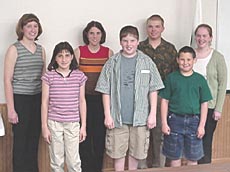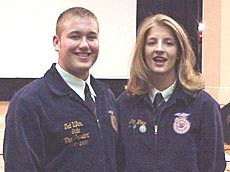|
Features,
Honors
& Awards, Ag
Announcements,
World
/ National
Ag News
|
|
Features
|
|
Hartem
FFA team competes in judging livestock
[MAY
1, 2001] The
Hartsburg-Emden FFA livestock judging team placed third at the
recent Section 14 Livestock Judging Contest.
|
|
Matt
Ballance was fourth-highest individual overall and third high in
swine judging.
Other
members of the team were Matt Duckworth, Nic Coers, Matt Wrage,
Daniel Coers, Brittney Kavanaugh, Kory Leesman, Josh Anderson and
Jacob Klokkenga.

|

[Members of the Hartem livestock judging team (left to right) are
Jacob Klokkenga, Josh Anderson, Kory Leesman, Brittney Kavanaugh,
Daniel Coers, Matt Wrage, Nic Coers, Matt Ballance and Matt
Duckworth.]
|
|

|
|
|
4-H
Oral Communications Contest results announced
[APRIL
28, 2001] Logan
County 4-H had its annual Oral Communications Contest recently.
Illinois State Fair delegates selected included Emily Bakken,
Lincoln, illustrated speech; Hans Bishop, Atlanta, illustrated
speech; Amanda Davison, Beason, formal speech; Andrew Fulton,
Lincoln, illustrated speech; Mathew Runyon, Broadwell,
demonstration; and Abrigail Sasse, Beason, original works. Selected
as an alternate was Kelly Cross, Hartsburg, in oral interpretation.
All were Blue Award winners. Abrigail Sasse was selected as the top
oral communicator and received a plaque sponsored by Lincoln IGA.
|
|

[Logan County 4-H Oral Communications Contest participants (left to
right, back row): Abrigail Sasse, winner, Beason; Emily Bakken,
Lincoln; Hans Bishop, Atlanta; Amanda Davison, Beason; (front) Kelly
Cross, Hartsburg; Andrew Fulton, Lincoln; Mathew Runyon, Broadwell.]
|
Judges
for this year's contests were Christina Wilkinson of Springfield and
Jo Ellen Maske of Mount Pulaski.
Oral
communication is a life skill taught and practiced in 4-H. To find
out more about the program, contact the Logan County Extension
Office, 980 N. Postville Drive in Lincoln, or call 732-8289.
[Patty
Huffer, Logan County Extension]
|
|
|
Logan
County 4-H’ers compete in meat judging
[APRIL
24, 2001] Logan
County 4-H members participated in the area 4-H Meats Judging
Contest April 19 at RMH Foods in Morton. Members of the local team
were Troy Tolan, Andrew Fulton, Rachael Jones, David Fulton and
Daniel Fulton. All were in the junior category of under 14 years of
age.
|
|
The
team placed third in the Junior Division.
Individuals
placing in the junior bracket were Andrew Fulton, placing third, and
Troy Tolan, placing fourth.
The
team was coached by Don Miller from the Logan County Extension
Office.
|

[Daniel Fulton, Rachael Jones, David Fulton;
(in back)
Andrew Fulton and Troy Tolan.]
|
|
|
Planting
progresses
By John
Fulton
[APRIL
23, 2001] Logan
County farmers are finally getting to roll in earnest on a
countywide basis. Earlier, there was quite a bit of field
activity in the southern portion of the county, but producers in the
northern half were at a standstill in many instances. It’s always
hard to estimate planting percentages when some are done planting
and others haven’t started, but the 50 percent level should come
close for our corn acres. This lags behind
averages for the last three years by up to 30 percent.
|
|
With
the type of farm equipment we are now using, the entire county could
be planted in about a week, give or take a day. With a few good days
of planting a great dent should be made in the half of the corn
acres not yet planted. What we really need is a greatly decreased
wind speed. The wind is making it hard to apply fertilizer and
chemicals and making it just plain hard to see. The wind is also
creating a very dry soil surface and wet zones underneath.

[Jack Knollenberg by Lawndale]
There
are a few soybeans planted in the county as well as corn, but the
number of acres is very minimal. In general, we say there is no
penalty for late planting in corn until we get into May. The penalty
is very small until May 4, and then we begin to lose a half percent
of yield a day. Soybeans can be planted through May with little
yield loss.
New
URL for Extension site
One
of the premiere web sites for agricultural economics information is
the Extension "farmdoc" site. The URL is http://www.farmdoc.uiuc.edu.
This URL is a little different than one I gave before, but the old
one will refer you to the new. A couple of things buried in the site
that are of interest this time of year are machinery cost estimates
and crop production costs.
Machinery
cost estimates are just that. These figures are calculated to
estimate what a particular farm operation costs you as an operator.
The specific URL for the costs is http://www.farmdoc.uiuc.edu//
manage/machinery/index.html.
[to top of second column in
this article]
|

[Bill Cross over by Hartsburg]
Keep
in mind that these are not custom rates. Custom rates are not
published by the University of Illinois. Custom rates are actually
surveys of people that do work on a custom basis. The U of I has
only put out the estimated cost of operations for as long as I can
remember. These figures are also what it is estimated to cost for
the power, machine, fuel and labor. No management charge is built
in. Many are interested in what the increase in diesel fuel price
will do to the rates. Gary Schnitkey at the U of I says the impact
will be in cents per acre at current fuel prices.
Another
area of interest this time of year is crop budgets. Check out the
budgets in the management area of farm.doc. With the estimated costs
of producing corn this year, total costs are estimated to be about
$2.68 per bushel with average input costs and 160-bushel corn
yields. Compare this to the current cash price of around $1.80 or
the loan rate of $1.95 and you can readily see that additional yield
or income is needed to break even (this does include a land cost of
$145 per acre).
Don’t
plan on making up for corn shortfalls on the soybean side. The
estimated break-even price for soybeans is $6.71 per bushel
(calculating $115 for land rent or equivalent). Compare this to
around $4 per bushel for harvest delivery or the $5.41 loan rate and
we are still a little short. Where is the difference made up? For
some it is in reduced costs, for others additional farm program
payments help, and for still others there is some erosion in
machinery equity.
At
any rate, current prices don’t offer a cash bonanza for local
farmers.
[John
Fulton]
|
|
|
Hartem
FFA members visit state officials in Springfield
[APRIL
11, 2001] Hartem
FFA members recently took part in Agricultural Legislative Awareness
Day in Springfield.
|
|
Nick
Alberts, Kyle Hoerbert, Matthew Wrage, Kory Leesman and Brittney Kavanaugh
assisted FFA members from around the state in distributing agricultural
commodity baskets and lunches to all the legislators.
These
members also got to visit with Director of Agriculture Joe Hampton and their
state representative, John Turner.
Also,
FFA member Anthony Jones was selected to serve as an honorary page in the House
of Representatives.
To
finish the day, these members toured the Illinois Vietnam and Korean War
Memorials, plus Lincoln's tomb.
[News
release]
|

[Pictured (left to
right) with Director of Agriculture Joe Hampton are Anthony Jones, Nick Alberts,
Joe Hampton, Kory Leesman, Kyle Hoerbert, Matthew Wrage, Brittney Kavanaugh and
Hartem FFA adviser Betsy Pech.]

[Hartem FFA members
(left to right) visiting with Rep. John Turner are Brittney Kavanaugh, Nick
Alberts, Mr. Turner, Kyle Hoerbert, Matthew Wrage and Kory Leesman.]
|
|
|
Producers
in alternative enterprises
have to ‘blaze their own trail’
[APRIL
9, 2001] When
we think of agriculture in Logan County and the central Illinois
area in general, we think of corn, soybeans, beef cattle and hogs.
All of those enterprises do exist, and in large numbers. Some of the
other enterprises help with farm income, provide for using extra
labor and fill niches created by consumers.
|
|
Logan
County operators have U-pick strawberry operations, asparagus plantings, herbs,
flowers, traditional garden produce, ostriches, emus, elk, Christmas trees,
ornamentals and just about anything else you can think of. Why? Because there is
a market, or they have created one.
That
is one of the toughest parts about alternative enterprises: marketing. It wouldn’t
be called alternative if existing markets were available to sell your produce.
Some of the strategies to sell alternative items are direct marketing, contract
production, grower cooperatives, buyer cooperatives and wholesaling where some
type of market does exist. Wholesaling is generally a last option since producer
profits tend to shrink with each marketing partner, but there is safety in being
able to sell at least some of the produce.
Many
producers in alternative enterprises have to "blaze their own trail."
Each one has to find out where a potential market exists and then produce for
that market. Many of these enterprises also are done on a small scale because
they are labor intensive. Think for a moment of picking 20 acres of strawberries
or hand-cutting 40 acres of flowers or herbs. A tenth of an acre is plenty for
many of these enterprises when you start out, but research must be done.
[to top of second column in this
article]
|
Existing
research done by third-party groups (such as colleges and universities) may be
hard to come by. That leaves producers trying to find others who have had
experience or possibly adapting information from other areas of the country or
overseas. Risk comfort level and the entrepreneurial spirit have a lot to do
with checking out alternative ag enterprises. If the tolerance for risk is low
or you want a ready-made market, many of the options (or possible cash
incentives) disappear.
The
newest trend among traditional producers is to produce something that is already
grown but has added value. For example, premiums are available for certain types
of soybeans that require only slight modifications in management. An extra 20
cents per bushel may worth using a special herbicide, storing the crop
separately and delivering the crop to a certain location. Most commonly this is
a type of contract production with a contract between a producer and a processor
or local elevator. The downside that we have already seen is that when several
producers are willing to produce the special crop, the premiums tend to
decrease.
University
of Illinois Extension in Logan County has been involved in value-added corn and
soybean plots for the last three years, and I will do some follow-up work later
this year with the soybean plots in place this year. We also conducted a major
producer survey last summer dealing with value-added crops and had producer
meetings this winter.
Alternative
enterprises aren’t for everyone. They can be a good option if the people
interested are able to "blaze their own trail."
[John
Fulton]
|
|
|
Honors
& Awards
|
|
Hartem
FFA member wins state award
|
|
[APRIL
5, 2001] Kate
Wrage was named the state winner in the Fruit/Vegetable category at
the recent Proficiency Awards Day judging. After progressing through
an interview, along with a review of her record books, Kate was
selected the state winner and will now represent Illinois at the
national FFA’s regional competition. Daniel Eeten, also of the
Hartem FFA, was chosen as the runner-up in Diversified Crop
Production.
|

[Ted Uftcus,
state FFA vice-president, and Kate Wrage.]
|
|
|
Ag
Announcements
|
|
|
|
Back
to top
|
News
| Sports
| Business
| Rural
Review | Teaching
& Learning | Home
and Family | Obituaries
Community | Perspectives | Law
& Courts | Leisure Time | Spiritual
Life | Health
& Fitness | Letters
to the Editor
|
|